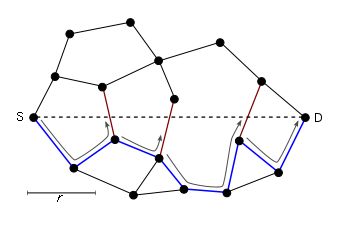
Geographic routing
Encyclopedia
Geographic routing is a routing
principle that relies on geographic position information. It is mainly proposed for wireless network
s and based on the idea that the source sends a message to the geographic location of the destination instead of using the network address. The idea of using position information for routing was first proposed in the 1980s in the area of packet radio networks
and interconnection networks
.
Geographic routing requires that each node
can determine its own location and that the source is aware of the location of the destination. With this information a message can be routed to the destination without knowledge of the network topology or a prior route discovery.
There are various approaches, such as single-path, multi-path and flooding
-based strategies (see
for a survey).
Most single-path strategies rely on two techniques: greedy forwarding and face routing. Greedy forwarding tries to bring the message closer to the destination in each step using only local information. Thus, each node forwards the message to the neighbor that is most suitable from a local point of view. The most suitable neighbor can be the one who minimizes the distance to the destination in each step (Greedy). Alternatively, one can consider another notion of progress, namely the projected distance on the source-destination-line (MFR, NFP), or the minimum angle between neighbor and destination (Compass Routing). Not all of these strategies are loop-free, i.e. a message can circulate among nodes in a certain constellation. It is known that the basic greedy strategy and MFR are loop free, while NFP and Compass Routing are not
.
Greedy forwarding can lead into a dead end, where there is no neighbor closer to the destination. Then, face routing helps to recover from that situation and find a path to another node, where greedy forwarding can be resumed. A recovery strategy such as face routing is necessary to assure that a message can be delivered to the destination. The combination of greedy forwarding and face routing was first proposed in 1999 under the name GFG (Greedy-Face-Greedy). It guarantees delivery in the so-called unit disk graph network model. Various variants, which were proposed later, also for non-unit disk graphs, are based on the principles of GFG
.
Routing
Routing is the process of selecting paths in a network along which to send network traffic. Routing is performed for many kinds of networks, including the telephone network , electronic data networks , and transportation networks...
principle that relies on geographic position information. It is mainly proposed for wireless network
Wireless network
Wireless network refers to any type of computer network that is not connected by cables of any kind. It is a method by which homes, telecommunications networks and enterprise installations avoid the costly process of introducing cables into a building, or as a connection between various equipment...
s and based on the idea that the source sends a message to the geographic location of the destination instead of using the network address. The idea of using position information for routing was first proposed in the 1980s in the area of packet radio networks
and interconnection networks
.
Geographic routing requires that each node
Node (networking)
In communication networks, a node is a connection point, either a redistribution point or a communication endpoint . The definition of a node depends on the network and protocol layer referred to...
can determine its own location and that the source is aware of the location of the destination. With this information a message can be routed to the destination without knowledge of the network topology or a prior route discovery.
There are various approaches, such as single-path, multi-path and flooding
Flooding algorithm
A flooding algorithm is an algorithm for distributing material to every part of a connected network. The name derives from the concept of inundation by a flood....
-based strategies (see
for a survey).
Most single-path strategies rely on two techniques: greedy forwarding and face routing. Greedy forwarding tries to bring the message closer to the destination in each step using only local information. Thus, each node forwards the message to the neighbor that is most suitable from a local point of view. The most suitable neighbor can be the one who minimizes the distance to the destination in each step (Greedy). Alternatively, one can consider another notion of progress, namely the projected distance on the source-destination-line (MFR, NFP), or the minimum angle between neighbor and destination (Compass Routing). Not all of these strategies are loop-free, i.e. a message can circulate among nodes in a certain constellation. It is known that the basic greedy strategy and MFR are loop free, while NFP and Compass Routing are not
.
 |  |
Greedy forwarding can lead into a dead end, where there is no neighbor closer to the destination. Then, face routing helps to recover from that situation and find a path to another node, where greedy forwarding can be resumed. A recovery strategy such as face routing is necessary to assure that a message can be delivered to the destination. The combination of greedy forwarding and face routing was first proposed in 1999 under the name GFG (Greedy-Face-Greedy). It guarantees delivery in the so-called unit disk graph network model. Various variants, which were proposed later, also for non-unit disk graphs, are based on the principles of GFG
.
See also
- List of ad-hoc routing protocols
- Backpressure RoutingBackpressure RoutingThis article describes backpressure routing forqueueing networks. It shows how the algorithm is derived and how its optimality is establishedusing concepts of Lyapunov drift....

